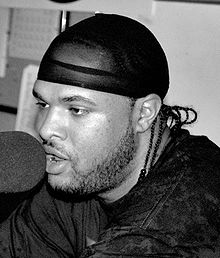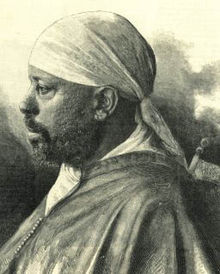- Do-rag
-
A do-rag, also spelled doo-rag, du-rag, durag, is a piece of cloth used to cover the head. According to the Oxford English Dictionary and Merriam-Webster the term derives from 'do as in hairdo.[1][2]
Contents
History
The do-rag was popular throughout many different eras. A popular misconception is that the do-rag is a recent African-American trend, but in actuality for centuries men and women of African descent from around the world have used various fabrics and scarves to cover their hair. The custom is known also from ancient China, where wrapping the hair (often held in a topknot) was common during physical labour and military service. However, the popularity of the Do-rag in the United States is attributed to African Americans.
Do-rags date back to the 1800s when freedom fighters put them under their hats to protect their necks from the sun. Later in the 1930s women wore bandana-like fabric to fasten their hairstyles in place while they set. In the 1940s the style among women shifted into the workplace where they were taking over factory jobs and needed a safe way to keep their hair out of the machinery. Rosie the Riveter is famously featured wearing the blue-collar woman's do-rag.
From the 1930s to the 1960s, they were used by African-American men to hold chemically processed hair-dos in place while they slept. Originally they were made from pieces of handkerchief, bandannas, or women's stockings; now many are made from polyester. Do-rags resurged as a fashion trend among urban youth in the 1970s and 2000s, first amongst African Americans, who used them to maintain their new hair styles. Do-rags are worn in a variety of colours, with black being the most common. Do-rags are regularly used to create and maintain waves. They are also used for cornrowed hairstyles. They usually have long ties on either side that are wrapped around the head to secure the do-rag and tied at the back.
It is also in widespread use among women who have had Japanese Hair Straightening done to their hair.
Uses
The do-rag may be worn by motorcycle riders to keep hair from blowing into the face and eyes, to keep bugs out of the hair and to absorb sweat. Generally; riders who use a do-rag do not wear a helmet. Nevertheless, the majority of these motorcyclists prefer the original bandanna. They are also worn by cyclists to prevent soreness of the head caused by wearing a helmet
Some motorcyclists, however, wear a do-rag beneath their helmets to reduce the amount of sweat and hair left behind in the helmet — thus reducing the need to wash the inside area of the helmet.
Do-rags are also common in the building trades, with many workers choosing to wear one under the hard hat to increase comfort and prevent sweat from getting into their eyes.
Black men also use do-rags to maintain the natural wave patterns in their hair. After intense brushing, an oil sheen, grease, or pomade is usually applied to the hair which is then wrapped in a do-rag overnight to prevent the waves from becoming tangled, especially if hair is long.
Other
In April 2000, the National Football League banned its players from wearing do-rags and bandanas underneath their helmets. The ban did not apply to players who wore them for medical reasons.[3]
A do rag is also reminiscent of a 'tichel': an Israeli style of head covering worn by Orthodox Jewish women. It can be a variety of colours and fabrics, but often it is longer than the average do-rag and tails down the back of the neck. Women who wear the do-rag style tichel often cut their hair short in accordance with Jewish law that stipulates that a woman's hair must be covered once married. Some women prefer to keep their hair long and tie the tichel in a knot at the back of their head, covering the hair within, this is less like the conventional do-rag. Tichel are colour co-ordinated to match clothing, but on special occasions white is a popular choice.
See also
References
- ^ do-rag, n. Oxford English Dictionary. Accessed 9 July 2008
- ^ do-rag. Merriam-Webster Online Dictionary. Accessed 9 June 2008.
- ^ NFL's New Rule Bans Do-Rags And Bandanas Worn On The Field - National Football League - Brief Article | Jet | Find Articles at BNET.com
Categories:- African-American culture
- Headgear
- Hip hop fashion
- Caps
Wikimedia Foundation. 2010.


